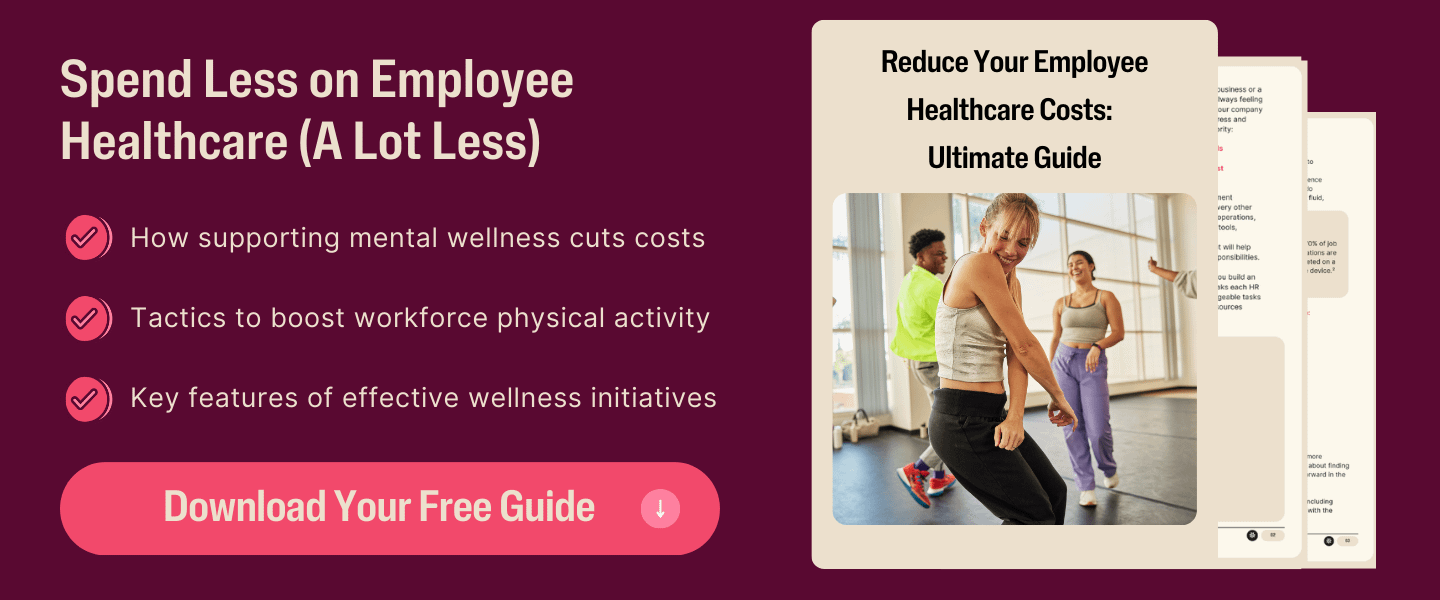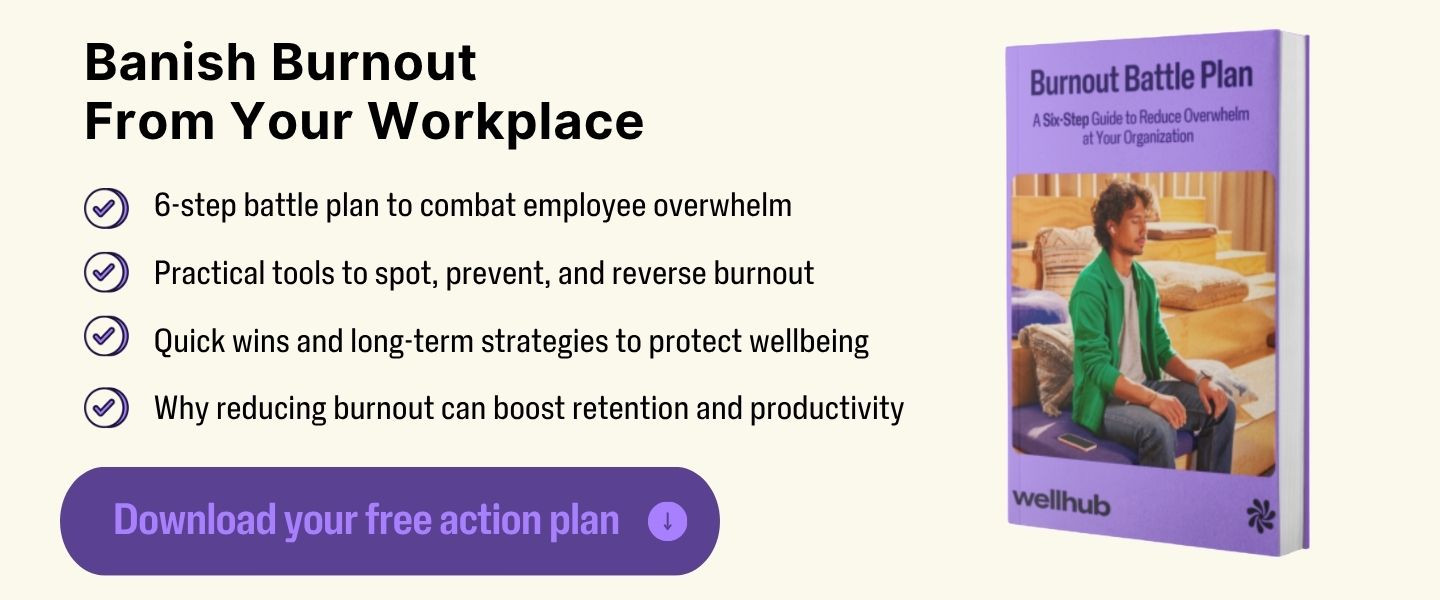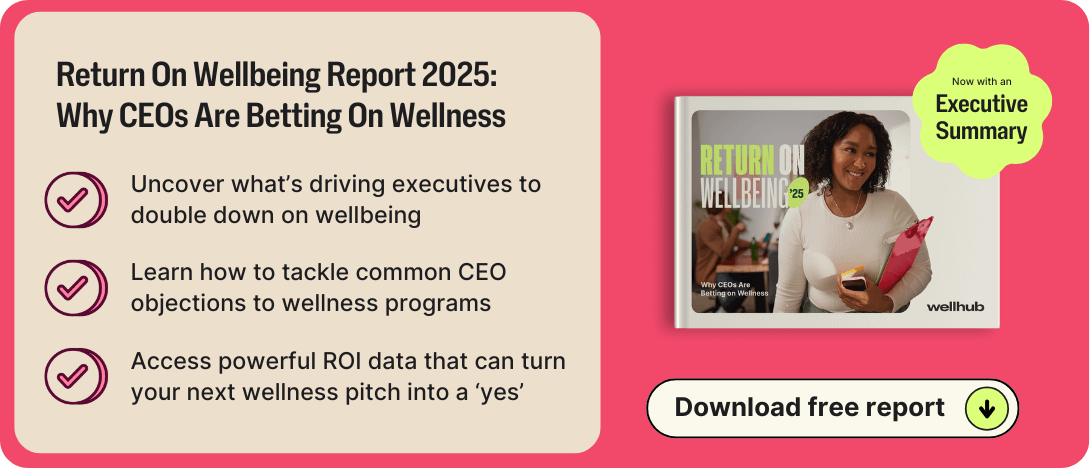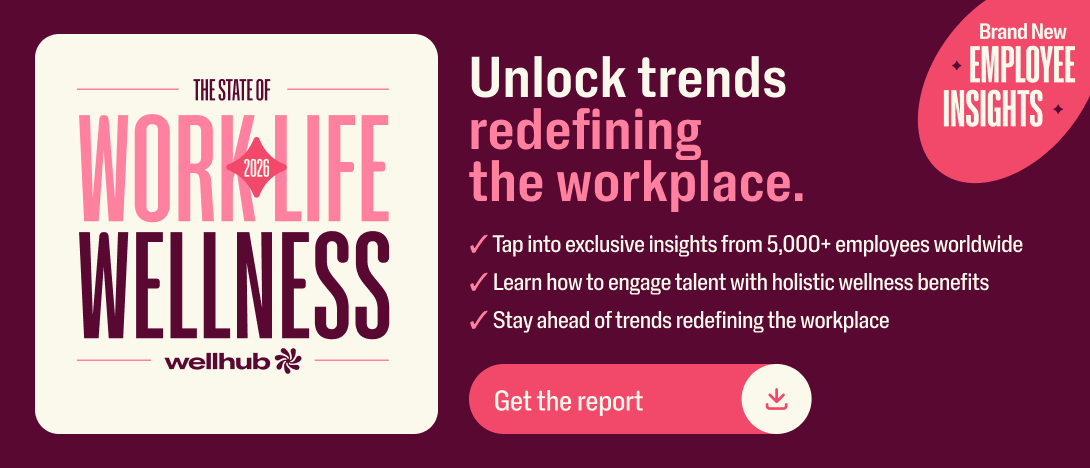The Cost of Employee Burnout and the ROI of Preventive Wellness
Last Updated Oct 22, 2025

It's a Tuesday morning, and you're neck-deep in work tasks. It took you 30 minutes to get out of bed this morning, and now your boss and colleagues are counting on you to deliver an important presentation. But your mind seems to be made of mud. You can't concentrate and feel short-tempered. You've noticed that these feelings have only been increasing. Is there something you can do to get out of this funk?
This is the dilemma of many workers around the world experiencing symptoms of burnout. It often starts unexpectedly, brought on by work or family stressors. It may go away within a day or two, but some people suffer silently for weeks, months, or even longer.
The cost of employee burnout is high for both workers and their employers. It can lead to reduced productivity and increased healthcare costs, while taking a toll on team morale, workplace dynamics, and the company's reputation. While burnout may not be completely avoidable, there are impactful ways to minimize it through preventative wellbeing.

What You’ll Learn:
- The True Cost of Burnout: Employee burnout costs U.S. businesses billions each year—averaging $4,000 per employee and up to $20,000 per executive. A 1,000-person company can lose over $5 million annually due to burnout-related losses.
- How Burnout Impacts Performance and Profit: From lost productivity, absenteeism, and presenteeism to higher turnover and healthcare costs, burnout drains both morale and money. Burned-out employees take 21% more sick days and are 3x more likely to job hunt, increasing replacement and training expenses.
- Cultural and Reputational Fallout: Burnout spreads like contagion—hurting team morale, collaboration, and customer experience. It can damage company culture, breed cynicism, and ultimately erode your brand’s reputation and attractiveness to top talent.
- Why Wellbeing is a Smart Investment: Wellness programs targeting the five pillars of wellbeing—physical, emotional, financial, career, and community health—deliver measurable returns. 82% of CEOs report a positive ROI, with 30% seeing 100%+ returns and 97% noting productivity gains.
- How to Prove and Maximize ROI: Learn how to calculate your wellness ROI by tracking healthcare savings, reduced absenteeism, and improved retention. Use a simple formula and data from before-and-after program metrics to demonstrate HR’s financial impact and secure future investment.
What Burnout Costs U.S. Businesses
It's easy to dismiss burnout as a temporary business setback, but it doesn't work like that. Burnout can hang around indefinitely, especially if employers (and workers) don't take action to fix it. And it doesn't only affect the worker experiencing it, but their coworkers and the entire business, too.
In a recent study, researchers tested the costs of employee burnout in the U.S. Using a computational model to calculate how much burnout hurts the annual bottom line, they found that burnout costs employers:
- $3,999 annually for non-managerial hourly U.S. employees
- $4,257 annually for non-managerial salaried U.S. employees
- $10,824 annually for managers
- $20,683 annually for executives
With these numbers, the study also calculated total burnout costs per employer. Employee burnout statistics showed that a 1,000-person company lost over $5 million due to burnout each year.
What do these monetary losses stem from? Here are some ways burnout can directly impact a company's bottom line.
Direct Costs of Burnout
Lost Productivity and Performance Declines
Burnout dramatically affects motivation and drive. When a person feels burned out, they struggle to take on a big new project or dream up an original idea. Instead, their focus is on simply making it through the day with as little friction as possible. Some work may not even get done, which is a big problem when you're on a deadline.
For employers, lost motivation and productivity translates into less output. Managers may notice more missed deadlines and avoidable mistakes as workers stop putting their best effort into their job. There may be fewer light-bulb moments, and unaffected employees may be stuck picking up the slack — and end up feeling burned out themselves.
Absenteeism and Presenteeism
Employees who are burned out take 21% more sick days than other workers, according to a study that analyzed 1,914 people over four years. It found that people suffering from burnout took an average of 10 days off per year, compared to 8.2 days for non-afflicted workers.
More absences aren't the only issue workplaces need to worry about. Workers experiencing burnout may also demonstrate presenteeism. In these cases, employees show up to work but can't do their job in their normal capacity. Presenteeism can result in an uptick in mistakes and reduced productivity. Some errors may be significant enough to have an impact on the company's bottom line.
Take the example of a sales manager suffering from burnout. The manager continues to go to work, even though they're struggling. When a potential client reaches out for a demonstration, they fail to adequately answer their questions, ultimately losing them to a competitor. Their mistake costs the company a customer and potential revenue.
The Price of Replacing Talent
Burned-out workers are also at a higher risk of leaving their roles. According to the Society for Human Resource Management (SHRM), employees experiencing burnout are three times more likely to be actively looking for a new job.
While someone with burnout may not be working up to their full ability, losing them hurts employers in the pocketbook as well. Companies may spend thousands to replace a burned-out worker. They will likely need to place a job ad, conduct interviews, and oversee pre-employment screening. Those costs average between $650 and $2,700, according to a Paychex analysis. Plus, new hires usually go through a training phase, so it can be several weeks before they're completely up to speed.
Increased Healthcare Costs
Burnout can lead to various physical and mental health symptoms. Some may be severe enough for an employee to seek help from a medical professional. Those medical visits can be costly, and they can add up. A Harvard University analysis found that up to 8% of annual spending on health care stems from workplace stressors, such as long hours. That equates to up to $190 billion annually.
When it comes time to renew your organization's insurance policy, you may face steeper premiums. That's because providers consider plan usage and claims history when determining costs.

Indirect and Cultural Costs of Burnout
Burnout doesn't only affect company financials. It can also be a drain on the workplace atmosphere. In the worst cases, burnout spreads across teams and departments — it can be as contagious as the common cold. As a consequence, team morale and collaboration drops, alongside customer experience and the company's reputation.
Team Morale and Collaboration
Think about the last time you were around someone who was in a bad mood. Were they pleasant to talk to? Or did they seem irritable, leaving you to close the conversation as quickly as you could?
Likely the latter. Burnout symptoms can turn the nicest person into someone difficult to be around. They may be quick to anger and eager to point out everything that's wrong. They may say rude things and be unwilling to pitch in on big projects. Unsurprisingly, this can be a drain on colleagues, who may not understand what's wrong — or what to do about it. Before you know it, you may be on a sinking ship of low morale.
Customer Experience and Brand Perception
Employees who work in customer-facing roles and suffer from burnout can unintentionally hurt your company's reputation. This can happen in several ways.
One possibility is mistakes. Burned-out employees may produce poor-quality and error-ridden work. Customers paying for a service or product may (rightfully) feel slighted and be less likely to purchase from your brand again.
Another concern is crabbiness. If an employee's interaction with a customer turns negative, it may change their view of your brand. In an open market with lots of competitors, customers want to shop with companies that value their business, not somewhere they don't feel appreciated.

Company Culture and Reputation
Burnout can cycle through your entire workforce if left to its own devices. If other employees see a teammate pushing through to the edge of exhaustion, they may start to believe that's what it takes to succeed in their role — especially if the person is in a leadership position or managing people.
This can create a toxic cycle, where everyone is pushing to outdo one another instead of working toward common goals. Outsiders considering a job with the company may turn it down because of the burnout culture.
Workplace Dynamics
Negativity, cynicism, and irritability are common traits among people suffering from burnout. While they may not mean to push their feelings on colleagues, they often do. This can hurt the overall workplace dynamic, increasing frustration and dissatisfaction among your team.
Workplace dynamics can also turn sour when employees take repeated sick days or fail to do their fair share. If one worker doesn't handle their responsibilities, their tasks will inevitably fall to their colleagues.
A recent study shows that when feelings of cynicism and exhaustion take over the workplace, a drop in engagement follows. That's why it's especially important to take action if you see worrisome signs of burnout. Opening up the doors of communication, and also encouraging a focus on wellness, may be what your employees need to shake those negative feelings.
How Preventative Wellbeing Contributes to Your Bottom Line
No workplace wants a burnout epidemic. Thankfully, there are ways to prevent employee burnout. One effective strategy is starting a wellbeing program.
Think of a wellness program as your burnout battle plan. Wellness programs encourage employees to focus on all five pillars of their wellbeing, including:
- Physical health: Fitness, preventative healthcare, and nutrition
- Emotional health: Mental wellbeing and stress management
- Financial health: Budgeting, financial planning, and debt mitigation
- Career health: Professional growth and learning
- Social health: Relationships with family, friends, and colleagues

A few examples of wellness programs include gym memberships, discounted therapy sessions, financial planning support, and career development tools. For a more effective and well-rounded experience, some organizations combine their wellness program with flexible work arrangements or an employee assistance program (EAP).
A wellness program can offer a range of benefits. If your organization doesn't yet have a wellness program, it's time to consider one. According to the Return on Wellbeing 2025 Study, 82% of CEOs reported a positive ROI from their wellness program. Other findings include:
- 67% of CEOs believe the wellness program reduced employee absenteeism rate.
- 97% of CEOs say the wellness program slightly improved productivity, and 47% said it had a significant positive impact on productivity.
- 73% of CEOs say the wellness program makes their organization more attractive to top talent and improves employee retention metrics.
- 68% of CEOs say that the wellness program reduced overall healthcare insurance costs.
- 73% of CEOs say that wellness initiatives improved employee resilience.
But what do the employees think of wellness programs? In the Wellhub's State of Work-Life Wellness 2026 report, 60% of employees with access to a wellness program reported thriving mental wellbeing. Among workers without access to a wellness program, only 40% reported satisfactory mental wellbeing.
Similar results were reported for physical wellbeing. Approximately 60% of employees with access to a wellness plan reported good or thriving physical wellbeing, compared to just 43% of workers who didn't have a wellness plan.
How to Mitigate the Costs of a Wellness Program
One reason why organizations may avoid a wellness plan is its cost. However, it's best to think of it as an investment in wellbeing, 82% of CEOs report a positive ROI from their wellness program. Three in four report returns greater than 50%, and 30% saw returns in excess of 100%—that means getting back $2 for every $1 invested in a wellness program.
Conversely, allowing employee burnout to fester may cost much more than a wellness plan in the long run. On average, burnout costs $4,000 per employee and can run up to tens of thousands of dollars for senior executives. If a company allows burnout to work its way through the staff, it could adversely affect its bottom line, as well as its reputation and standing with customers.
How to Calculate Your Wellness ROI
Measuring the return on your employee wellness program doesn’t have to be a mystery. In fact, it’s one of the best ways to demonstrate HR’s contribution to your organization’s financial success—and to secure more budget. Let’s walk through how you can calculate it.
Step 1: Identify Direct Costs of Your Wellness Program
Start by calculating your total investment. This includes:
| Cost Category | Examples |
|---|---|
| Program Fees | Subscriptions to wellness platforms like Wellhub |
| Staffing | Salaries for wellness coordinators or program leads |
| Communications | Internal promotions, events, onboarding materials |
| Incentives | Gift cards, gym memberships, wellness challenges |
Step 2: Pinpoint the Benefits You Want to Measure
Think productivity gains, healthcare savings, and retention improvements. These are your return metrics.
Here are a few commonly used wellness ROI indicators:
- Reduced healthcare claims
- Lower absenteeism/presenteeism
- Improved employee retention
- Increased productivity
- Higher engagement scores

Step 3: Collect Pre- and Post-Program Data
This is where HR shines. Dig into your people data before and after implementation.
| Metric | Pre-Program Example | Post-Program Example |
|---|---|---|
| Annual Healthcare Cost per Employee | $4,500 | $3,900 |
| Absentee Days per Employee | 5.2 | 3.8 |
| Annual Turnover Rate | 21% | 17% |
Step 4: Calculate ROI Using a Simple Formula
Here’s a classic ROI formula to use:
ROI (%) = [(Total Benefits - Total Costs) / Total Costs] × 100
Example
Let’s say:
- You spend $150,000 annually on a wellness program.
- You save $225,000 across healthcare claims, reduced absenteeism, and lower turnover.
ROI = [(225,000 - 150,000) / 150,000] × 100 = 50% ROI
That’s a solid return—and aligns with real-world outcomes. In fact, 78% of CEOs report returns greater than 50%, and 30% saw returns over 100%.
Partnering with a company like Wellhub can also help you calculate your wellness ROI with data-driven insights. Use the platform to track enrollments and usage.
Burnout Is Expensive—But Preventable with the Right Support
Burnout drives up costs through lost productivity, absenteeism, turnover, and higher healthcare spending. It also damages team morale, weakens company culture, and pushes top talent out the door.
A strong employee wellbeing program tackles burnout before it spirals. With support across mental, physical, financial, and career health, employees feel more resilient and engaged. According to the Return on Wellbeing 2025 study, 97% of CEOs said their wellness program improved productivity, and 73% saw better retention. That impact adds up—especially when burnout costs employers thousands per employee each year.
Speak with a Wellhub Wellbeing Specialist to reduce burnout, cut costs, and build a culture that keeps your best people thriving.

Company healthcare costs drop by up to 35% with Wellhub*
See how we can help you reduce your healthcare spending.
Category
Share

The Wellhub Editorial Team empowers HR leaders to support worker wellbeing. Our original research, trend analyses, and helpful how-tos provide the tools they need to improve workforce wellness in today's fast-shifting professional landscape.
Subscribe
Our weekly newsletter is your source of education and inspiration to help you create a corporate wellness program that actually matters.
Subscribe
Our weekly newsletter is your source of education and inspiration to help you create a corporate wellness program that actually matters.
You May Also Like

Corporate Wellness Trends HR Must Know for 2026 | Wellhub
See the top 2026 wellness trends shaping performance, retention, and culture—plus how HR can build a unified, ROI-driven wellbeing strategy.

Wellness Points Programs: Boost Employee Health & Engagement | Wellhub
Turn your workplace wellness strategy around with a points program that rewards healthy behavior with perks, from extra time off to gift cards.

Employee Financial Wellness Programs: Ultimate HR Guide | Wellhub
Create an effective financial wellness program that supports your employees in their financial needs, boosting productivity and retention.